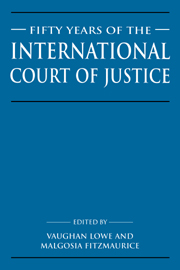Book contents
- Frontmatter
- Contents
- List of contributors
- Preface
- List of abbreviations
- Sir Robert Yewdall Jennings, by Vaughan Lowe
- List of publications of Sir Robert Jennings
- Table of cases
- Part I The International Court of Justice
- Part II The sources and evidences of international law
- Part III Substance of international law
- 10 The Court's role in relation to international organizations
- 11 Cases of the International Court of Justice relating to employment in international organizations
- 12 Jurisdiction and immunities
- 13 Adjudication as a mode of acquisition of territory?
- 14 Equitable maritime boundary delimitation
- 15 Environmental protection and the International Court of Justice
- 16 The contribution of the International Court of Justice to air law
- 17 The treatment of human rights and of aliens in the International Court of Justice
- 18 The International Court of Justice and the right of peoples to self-determination
- 19 The International Court of Justice and the peaceful settlement of disputes
- 20 The International Court of Justice and the use of force
- Part IV Procedural aspects of the work of the International Court of Justice
- Part V The International Court of Justice and the United Nations
- Index
16 - The contribution of the International Court of Justice to air law
Published online by Cambridge University Press: 02 November 2009
- Frontmatter
- Contents
- List of contributors
- Preface
- List of abbreviations
- Sir Robert Yewdall Jennings, by Vaughan Lowe
- List of publications of Sir Robert Jennings
- Table of cases
- Part I The International Court of Justice
- Part II The sources and evidences of international law
- Part III Substance of international law
- 10 The Court's role in relation to international organizations
- 11 Cases of the International Court of Justice relating to employment in international organizations
- 12 Jurisdiction and immunities
- 13 Adjudication as a mode of acquisition of territory?
- 14 Equitable maritime boundary delimitation
- 15 Environmental protection and the International Court of Justice
- 16 The contribution of the International Court of Justice to air law
- 17 The treatment of human rights and of aliens in the International Court of Justice
- 18 The International Court of Justice and the right of peoples to self-determination
- 19 The International Court of Justice and the peaceful settlement of disputes
- 20 The International Court of Justice and the use of force
- Part IV Procedural aspects of the work of the International Court of Justice
- Part V The International Court of Justice and the United Nations
- Index
Summary
The International Court of Justice has not had, as yet, an appropriate opportunity to contribute in a major way to the development of air law; it has, however, had the chance to deal with some aspects of air law in some of the cases submitted to it. The following are the cases that refer to some elements of air law: the Aerial Incident, 1955 (Israel v. Bulgaria), the Appeal Relating to the Jurisdiction of the ICAO Council, 1972 (India v. Pakistan), Military and Paramilitary Activities in and against Nicaragua, 1986 (Nicaragua v. USA (Merits)); the Aerial Incident, 1988 (Iran v. USA);4 and the two cases over the Lockerbie Incident, 1992 (Libya v. UK) and (Libya v. US).
There were other cases involving military aircraft, but the ICJ was unable to deal with them for lack of jurisdiction, e.g. Treatment in Hungary of Aircraft and Crew of USA, 1954 (USA v. Hungarian People's Republic). The Court ordered that the case be removed from the list because of lack of jurisdiction.
THE AERIAL INCIDENT, 1955
This was a case of the shooting down of an El Al aircraft, on a scheduled flight from Vienna to Tel Aviv, by Bulgaria, over Bulgarian territory. The incident resulted in the death of the seven crew members and fifty-one passengers of varying nationalities. Israel made an application to the ICJ invoking the Bulgarian declaration of acceptance of the jurisdiction of the Permanent Court of International Justice of 1921.
- Type
- Chapter
- Information
- Fifty Years of the International Court of JusticeEssays in Honour of Sir Robert Jennings, pp. 316 - 326Publisher: Cambridge University PressPrint publication year: 1996



